Stuart Weitzman School of Design
102 Meyerson Hall
210 South 34th Street
Philadelphia, PA 19104
Get the latest Weitzman news in your Inbox
A Civic Vision for the Central Delaware was created through a citizen-driven, open and transparent planning process. The public nature of the planning process attracted press coverage, enabling the conversation to remain public and vigorous and ensuring that special interests were not allowed to dominate the outcome. PennPraxis, together with the Penn Project on Civic Engagement, developed a process of creating a vision plan that married citizen values with professional knowledge. Since October 2006, the process has engaged more than four thousand Philadelphians in a robust civic dialogue that has included citizens, business leaders, elected offi cials, developers and design professionals.
An Open and Transparent Planning Process (pdf)
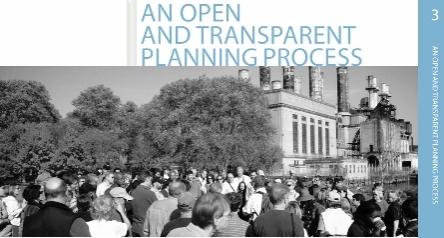
The Central Delaware Advisory Group
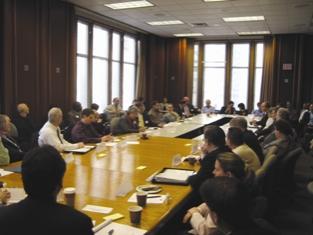
The Central Delaware Advisory Group, chaired by the Philadelphia City Planning Commission’s executive director, Janice Woodcock, began meeting monthly in November 2006. The group included forty-six appointed public officials, business leaders and community group members. The advisory group also selected a steering committee, which met as needed over the course of the process. Members of the advisory group visited New York City in November 2006 to meet with various planners and officials and learned about New York’s diverse waterfront initiatives. Each representative served an important role in the advisory group, helping to guide the process to ensure that it remained thorough and embodied shared values.
PlanPhilly
In October 2006, PennPraxis launched www.planphilly.com, a portal for content on planning and urban-design issues in the Philadelphia area. Since January, the site has kept the public up to date on the status of the civic vision and helped to educate its visitors on riverfront issues through interactive applications that encourage local citizens to use the Web for civic engagement. PlanPhilly earned honorable mention on Planetizen’s list of Top 10 Best Planning Websites of 2007 and had over eighty thousand unique visitors in its first nine months.
A Year of Civic Engagement
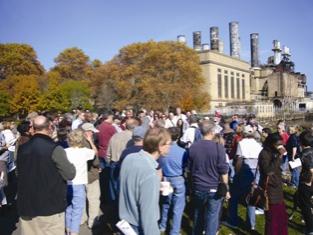
Fall 2006, Riverfront Walks
PennPraxis led over three hundred citizens on several guided riverfront tours. During the tours, many participants shared their stories and knowledge of the central Delaware riverfront. These walks marked the beginning of a process in which neighbors, public officials and design professionals came together to envision a new future for the riverfront. As such, they sent the important signal that the process begins with the public at the water’s edge.
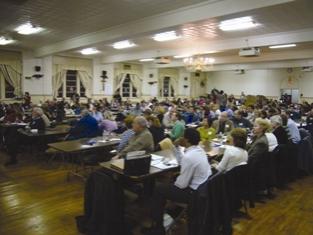
December 2006, Community Forum: Value Sessions
The Penn Project on Civic Engagement facilitated three outreach sessions in Kensington, South Philadelphia and Penn’s Landing. The value sessions, organized around small-group discussions, encouraged citizens to describe valued aspects of their communities. Over 850 Philadelphians participated in creating a list of community-derived values.
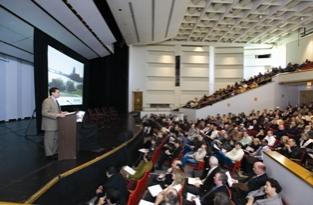
February 2007, Community Forum: Best Practices Session
PennPraxis invited local and national experts to the Independence Seaport Museum to provide Philadelphia with a crash course in various aspects of waterfront development. Through discussions focused on ecology, sustainable systems, challenges of large-scale urban design and models for waterfront planning implementation, over four hundred Philadelphians began to believe in the potential for the development of a twenty-first century riverfront and to understand the long-term effort necessary to achieve such a goal.
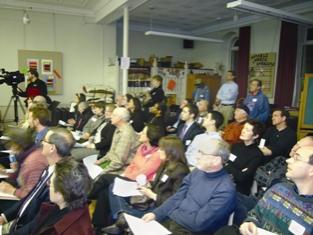
February 2007, Community Forum: Principles Sessions
Following the identification of community values and best practices, PennPraxis gathered over 450 residents of Society Hill, Kensington and Pennsport to develop a series of planning principles. These principles became the blueprint upon which the vision plan was based.
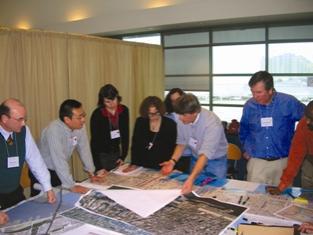
March 2007, Design Workshop
PennPraxis, the Philadelphia City Planning Commission and planning consultants Wallace Roberts & Todd organized and facilitated a design workshop at which participants were asked to imagine a new future for the Delaware riverfront. Five world-renowned designers led teams of local planning professionals, community members and design students through three days of collaborative brainstorming and intensive designing. Using the citizen-derived planning principles as their foundation, the teams imagined a fully transformed central Delaware riverfront. Over five hundred citizens attended the standing-room-only presentation at the Independence Seaport Museum to see the work of the design teams, and many of the ideas were published in the Philadelphia Inquirer and the Philadelphia Daily News and presented on local television and radio stations. During the workshop, three essential planning networks were identified: movement systems, open space and land development. These three networks became the basis for this vision plan.
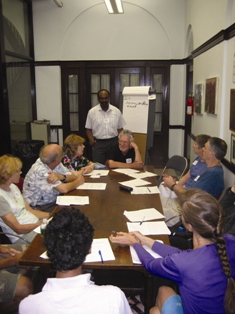
Spring and Summer 2007, Design and Community Feedback
Throughout this planning process, many community and riverfront stakeholders played important roles in refining the citizen and expert recommendations for riverfront design and implementation. The Penn Project on Civic Engagement facilitated a series of citizen feedback sessions in Northern Liberties and Queen Village, as well as holding smaller community meetings in Washington Square, Port Richmond and New Kensington. Approximately four hundred local residents provided comments on many elements of the design and development guidelines. Their feedback served as a checkpoint, enabling the team to see if the design ideas in development were conveying the public’s voice appropriately.
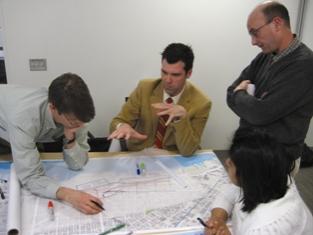
Summer 2007, Collaboration and Outreach
Recognizing that the Central Delaware Riverfront Vision Plan requires cooperation at many levels (neighborhood, city, state and region), PennPraxis convened multiple focus groups to obtain specific information on the specialized disciplines, key projects and upcoming work of various public agencies. These included internal workshops and information-sharing sessions with historic preservation experts, parks groups and the broader development community. The team also consulted with the Pennsylvania Department of Transportation, the Philadelphia Water Department, the Center City District, the Design Advocacy Group, the Pennsylvania Horticultural Society, the Pennsylvania Environmental Council, the Philadelphia Regional Port Authority, the Delaware River Port Authority and the Penn’s Landing Corporation, among others. In addition, the project team worked with local developers and promoted the plans of local neighborhood groups, including the New Kensington Community Development Corporation, Neighbors Allied for the Best Riverfront, the Delaware River City Corporation and the Northern Liberties Neighbors Association.
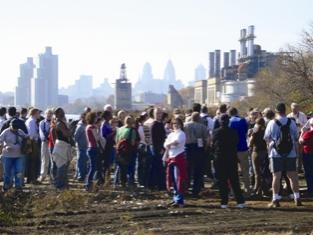
November 2007, Public Presentation of the Civic Vision
PennPraxis hosted the public unveiling of the Central Delaware Riverfront Vision Plan. The presentation offered local citizens and others an opportunity to see how the civic values and principles developed through public outreach have been translated into a long-term vision for Philadelphia’s riverfront.
Values and Principles
A Civic Vision for the Central Delaware relied upon the efforts of thousands of committee members, residents, business owners, community leaders and government officials to define the values and principles that best reflect Philadelphia’s distinctive characteristics. The following values and principles form the core of the civic vision.
Values
The following list reveals neighborhood features that citizens told our team are important. We have sought to retain some of their language.
A safe place to live
We value a neighborhood in which children can play outside, one where adults and kids alike walk the neighborhood and feel safe because they know and trust one another, whether they live or work in the community.
A varied culture
We appreciate the economic, ethnic, racial, cultural, generational and physical (ecological and architectural) diversity in our neighborhoods.
A healthful environment
We value a clean and open environment—including the river, trees and air—and want access to that environment.
Economic sustainability
We recognize that quality jobs on the riverfront are an economic engine of the city. It is important that we sustain, if not expand, industrial and shipping jobs, as well as small, locally owned businesses. This will provide a strong economy for adults, as well as jobs for youth.
A rich history
We value Philadelphia’s history as the birthplace of democracy in the United States and as a city to which different ethnic groups have immigrated and in which they have prospered. The traditions, buildings, cultural institutions and activities, educational institutions and other features that have grown from that history make Philadelphia unique.
Planning Principles derived from Citizen Values
Reconnect the city to the river’s edge
Build Philadelphia to the river. Split up the sprawling, super-block-style street layout that damages the character of the central Delaware, and link the waterfront physically and visually to adjacent neighborhoods. Reuse historic structures to hold on to traces of Philadelphia’s past. Bring the narrow, neighborly grid of streets to the river’s edge so that dense intimate communities can thrive, increasing the sense of safety and strengthening community pride. Remove barriers to waterfront access and make it safe to work, walk and play in this new district. Reduce car traffic on Columbus Boulevard/Delaware Avenue and Interstate 95 so the human-scale city can flow to the river. Use innovative mass transit, car sharing and automated-parking techniques so that people can visit the waterfront without having to drive.
Honor the river
Acknowledge the role the river has played in shaping Philadelphia, as well as its importance today. Support the needs of the shipping industry and Philadelphia’s working port as a vital part of the city’s current and future economic base. At the same time, think of the river as a series of interlocking systems—economic, recreational, transportation, residential, cultural and commercial—and work to manage the river’s multiple uses and needs. Improve public access for boating, recreation and leisure. Maintain the health of the river for future generations. Build on Philadelphia’s relationship with Camden, its neighbor on the New Jersey side of the Delaware River, and create water-taxi and ferry services to enhance the connections.
Design with nature
Remember that the Delaware River is a giant watershed. Plan development along the river’s edge carefully so that natural sites can coexist with residences, businesses and the working port. Practice effective water management to reduce stormwater runoff from new development, and create new streams and inlets where paved-over creeks once fed into the Delaware. Encourage new development that enhances the river’s ecology and environment rather than degrading it. Promote “green” building technologies and remediate and develop vacant brownfields in ways that celebrate the industrial past while creating new uses for the twenty-first century. Offer good mass transit along the waterfront to reduce car pollution and congestion.
Strike the right balance
Create a livable and walkable community along the entire water’s edge by encouraging a healthy mix of urban development and public improvements. Successful sites offer a blend of uses throughout the day and the year, so no single type of activity should dominate the central Delaware waterfront. Encourage a healthy public life along the water’s edge with a careful balance of public spaces, shops, cafés and residences. Design Delaware Avenue/Columbus Boulevard to be one of the great boulevards of the world, one that manages traffic artfully, encourages a mix of uses with ground-level activity to keep streets populated and includes a variety of lively public spaces. Promote dense, human-scale development that brings people and urban energy to the river. Create a destination for local residents and visitors that adds to Philadelphian’s sense of hometown pride. Beautify the public realm through signage, public art and landscaping.
Take the long view
Do not be seduced by short-term gains in developing the central Delaware. Think big and create bold plans for the future of I-95 at Penn’s Landing, the connections between the river and the neighborhoods and the possibilities for creating a world-class waterfront. Seize the opportunity to create a visionary road map for large-scale public investment in Delaware Avenue/Columbus Boulevard, mass transit and the creation of generous public spaces. Encourage high-quality private urban development and support it with urban-design excellence in the public realm. Aim high and put forward a vision that can be implemented in phases over the next fifty years. Cultivate farsighted civic and political leadership to put the plan into action.
Protect the public good
Connect city neighborhoods to the waterfront through a new and distinct network of public places that tells the story of Philadelphia and the Delaware River. Reach out along the river to the north and the south—beyond the central Delaware—and link the central region with the public improvements planned for those other areas. Develop a waterfront that will bring different types of people together through shared experiences of public spaces. Establish the waterfront as a meeting place for all Philadelphia residents, and provide multiple access points for neighbors to use. Plan for a diverse built environment as well as a diverse community of residents. Develop public policies that encourage a variety of housing opportunities for citizens of mixed income levels and backgrounds and that protect the quality of life for local community members.
Make it real, Philadelphia
Honor Philadelphia’s illustrious past and promising future through the design of the central Delaware. Make the riverfront a real place based on local values by ensuring that the implementation of the civic vision for the central Delaware is based on sustained citizen engagement. Tap into Philadelphia’s vast wealth of design excellence for inspiration while making sure that the vision for the central Delaware is truly contemporary. Create a lasting legacy of urban- design excellence for generations to come through the thoughtful balance of public good and private development. Continue making citizen input a priority as the plan for the central Delaware takes shape so that this vital dialogue can continue to inform development.
Looking to the Future
Through the process of civic engagement described above, local designers, elected officials and neighborhood stakeholders formed partnerships and began to collaborate in new and creative ways. These relationships are an early win for the civic vision. In addition, the active and sustained participation of the public reveals the community’s eagerness to become involved in forming a comprehensive vision for the future of the riverfront that is based on shared civic values. This active public involvement sends the strong and clear message that Philadelphians want their city to abandon the traditional method of transactional, parcel-based planning and development without regard to the greater public good.
Philadelphia will benefit by continuing this sustained and active civic engagement at both neighborhood and city-wide levels. It is essential that community leaders continue to mobilize Philadelphians into action to ensure that public and private interests work together to identify common ground and set priorities for future growth and development along the central Delaware riverfront. Community members want development that places the public good at the forefront. They want progressive public policies to be created and implemented—policies that ensure that the look and feel of the central Delaware will be inviting and provide an example of sustainable development for generations to come.
